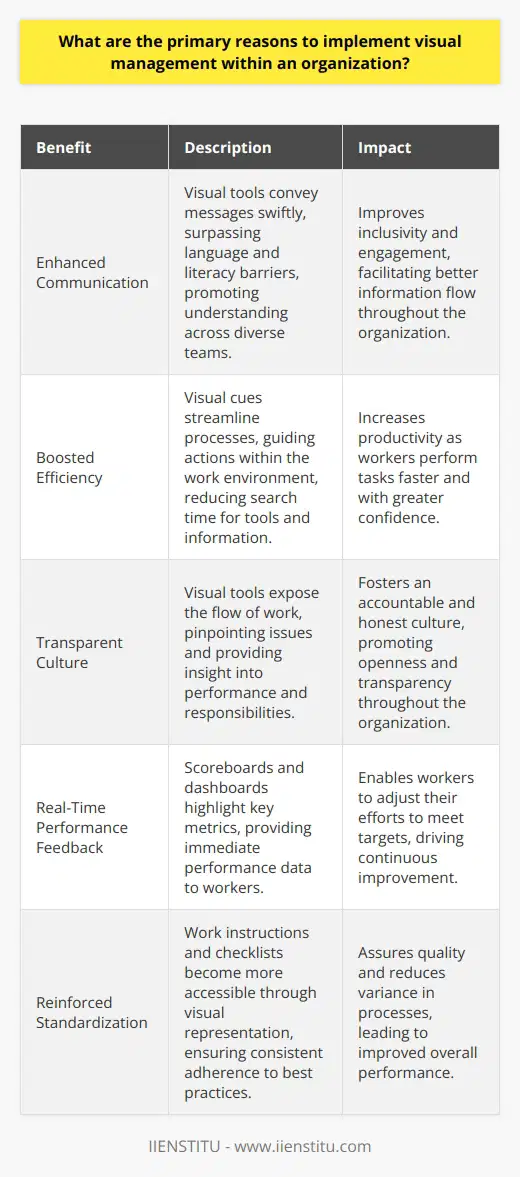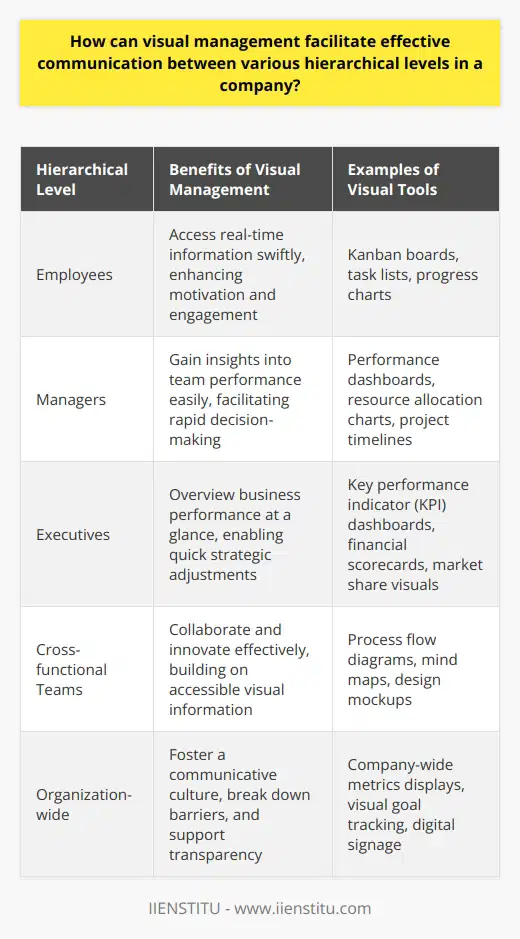
There's something delightfully reassuring about walking into a workspace and immediately understanding how things flow, isn't there? I remember the first time I visited a friend’s manufacturing plant; I was struck by how visual cues guided every aspect of the operation. It wasn't just about aesthetics; it was an orchestrated symphony of shapes, colors, and signs that made everything click into place. This seamless experience was my first encounter with the power of visual management, and it left quite an impression.
Embracing Visual Management in Everyday Operations
The Journey Begins
Back when I was managing my own small team, I often found communication to be a bit of a maze. Emails got lost, memos went unread, and important information slipped through the cracks. One day, after yet another missed deadline, I stumbled upon a book called The Visual Factory by Michel Greif. It was like a lightbulb went off in my head. The concept of visual management wasn't just for big factories or manufacturing plants—it could transform any workspace, including mine.
I started by introducing simple visual boards in our office. We pinned up project statuses, deadlines, and key performance indicators where everyone could see them. Almost overnight, the atmosphere changed. Team members began to take ownership of their tasks, discussions became more focused, and there was a newfound energy in the room. It was clear: visual management was more than just a tool—it was a catalyst for change.
The Core Principles That Made a Difference
Clarity is Key
One of the first things I learned was the importance of clarity. In our visual boards, we made sure that everything was presented in a way that was easy to understand at a glance. We used bold headings, color-coded stickers, and straightforward language. This eliminated confusion and ensured that everyone was on the same page.
For instance, we used red tags for urgent tasks, yellow for in-progress items, and green for completed ones. It might seem simple, but this color-coding system made a world of difference. No more sifting through lengthy emails to find out what needed immediate attention—the information was right there, clear as day.
Accessibility Matters
But clarity was just the beginning. Accessibility played a crucial role too. We placed these boards in a central location where the entire team could easily view them, not tucked away in some corner. This meant that during quick stand-up meetings, we could all refer to the same visual aids, making our discussions more productive.
I recall a time when one team member was unaware of a change in project scope. By having the updated information displayed prominently, we avoided a potential misstep. It's amazing how timely access to visual information can keep everyone aligned and moving forward together.
Consistency Creates Comfort
We also learned that consistency was essential. We standardized our visual cues so that everyone knew exactly what each symbol, color, or label meant, no matter which project they were working on. This uniformity reduced misunderstandings and created a sense of reliability in our communication methods.
I remember visiting a larger corporation and noticing how they implemented similar practices on a grander scale. They used consistent signage throughout their facility, which not only improved efficiency but also enhanced safety. It reinforced my belief that whether in a small team or a large organization, consistent visual management practices can have a significant impact.
Tools and Techniques That Transformed Our Workflow
The Power of Visual Boards
Our journey with visual boards didn't stop at project statuses. We expanded their use to include:
Idea Boards: Encouraging team members to post suggestions.
Feedback Walls: A place for anonymous feedback to improve processes.
Celebration Corners: Highlighting team achievements and milestones.
These boards became an integral part of our team culture, fostering transparency and open communication.
Embracing Performance Metrics
We also started displaying performance metrics prominently. By showcasing our progress towards goals with charts and graphs, the team could see the direct result of their efforts. It was motivating to watch the lines on the graph trend upward because of our collective hard work.
Once, during a particularly challenging quarter, seeing our progress visually helped the team rally together. It wasn't just about numbers on a spreadsheet; it was a visual story of our journey, highlighting both our struggles and triumphs.
Utilizing Control Charts
Incorporating control charts was another game-changer. Although initially used in more technical fields, we adapted them for our needs. They helped us monitor our processes and identify any deviations from our standards.
For example, we tracked the time it took to complete certain tasks. When we noticed spikes in the chart, it prompted us to investigate and address any underlying issues. This proactive approach improved our efficiency and enhanced decision-making within the team.
The Tangible Benefits We Experienced
Boosting Efficiency the Visual Way
The most noticeable benefit was the increase in efficiency. By streamlining information flow and making it visually accessible, we reduced unnecessary meetings and emails. Team members knew where to find the information they needed and could focus more on their actual work.
In fact, a study I came across in Lean Thinking by James P. Womack and Daniel T. Jones emphasized how visual management can cut down waste in processes. We saw this firsthand as we eliminated redundant steps and optimized our workflow.
Enhancing Communication Across the Board
Our communication improved dramatically. Visual cues bridged gaps that words sometimes couldn't. This was especially helpful when working with team members from different cultural backgrounds or those who preferred visual learning.
I recall collaborating with a colleague who was new to the country. The visual aids helped her get up to speed quickly without feeling overwhelmed by language barriers. It was heartening to see how visual management fostered inclusion and teamwork.
Making Better Decisions, Together
By having key information displayed visually, decision-making became a collaborative and informed process. We could spot trends, identify bottlenecks, and brainstorm solutions as a team.
During one project, we faced a significant delay due to supplier issues. By mapping out the project timeline visually, we were able to adjust our plans and mitigate the impact efficiently. It wasn't just about reacting to problems—it was about anticipating them and staying ahead of the curve.
Beyond the Workplace: Visual Management in Daily Life
Bringing It Home
Interestingly, the principles of visual management spilled over into my personal life. I started organizing my home using similar techniques. From color-coded calendars to labeled storage, the benefits were undeniable.
My family embraced it too! The kids loved the visual cues for their chores and schoolwork. It became a fun way to stay organized and reduced the usual chaos of a busy household.
Tips for Writing Effective Communication
Now, you might wonder, how does this relate to reassignment request letters? Well, the principles of visual management can enhance written communication too. When drafting a reassignment request letter, clarity, accessibility, and consistency are vital.
Here are some reassignment request letter tips and information:
1- Be Clear and Concise: Clearly state your request and the reasons behind it.
2- Organize Your Thoughts: Use bullet points or numbered lists to structure your letter.
3- Consistent Formatting: Maintain a uniform format throughout the letter for professionalism.
4- Make It Accessible: Use language that is easy to understand, avoiding jargon.
5- Highlight Key Points: Use bold or italics to emphasize important information.
By applying visual management principles, your letter becomes more effective, increasing the likelihood of a positive response.
Implementing Visual Management in Various Industries
Manufacturing and Beyond
While visual management is often associated with manufacturing—think of Toyota's famous production system—it’s incredibly versatile. Industries such as healthcare, education, and even software development have adopted these practices.
In healthcare, for example, color-coded charts and visual cues are used to enhance patient care. According to Managing the Unexpected by Karl E. Weick and Kathleen M. Sutcliffe, visual management plays a crucial role in high-reliability organizations like hospitals.
The Role of Technology
With advancements in technology, digital visual management tools have emerged. Software applications allow for virtual boards, making it easier for remote teams to stay connected and informed.
During the recent shift to remote work, my team utilized digital visual boards. It was fascinating to see how the core principles remained effective, even in a virtual environment. The technology amplified the benefits, providing real-time updates and facilitating collaboration across distances.
Final Thoughts: The Lasting Impact of Visual Management
Reflecting on my journey, it's clear that visual management has been more than just a set of tools—it’s been a transformative approach that reshaped how I work and communicate. The principles of clarity, accessibility, and consistency have applications far beyond the workplace.
Whether you're looking to improve team dynamics, enhance efficiency, or even craft the perfect reassignment request letter, embracing visual management can lead to profound changes. It's about making information visible and understandable, fostering an environment where everyone can thrive.
Resources for Further Exploration
If you're interested in diving deeper, here are some excellent resources:
Gemba Kaizen by Masaaki Imai
The Visual Factory by Michel Greif
Lean Thinking by James P. Womack and Daniel T. Jones
Managing the Unexpected by Karl E. Weick and Kathleen M. Sutcliffe
These books offer valuable insights into the techniques and philosophies behind visual management.
References
1- Imai, M. (1997). Gemba Kaizen: A Commonsense Approach to a Continuous Improvement Strategy. McGraw-Hill.
2- Greif, M. (1991). The Visual Factory: Building Participation Through Shared Information. Productivity Press.
3- Womack, J. P., & Jones, D. T. (1996). Lean Thinking: Banish Waste and Create Wealth in Your Corporation. Simon & Schuster.
4- Weick, K. E., & Sutcliffe, K. M. (2007). Managing the Unexpected: Resilient Performance in an Age of Uncertainty. Jossey-Bass.
Frequently Asked Questions
What are the primary reasons to implement visual management within an organization?
Understanding Visual Management
Visual management stands out in modern organizational practices. It embodies the principle of "a picture is worth a thousand words". This philosophy leverages visual tools to manage and communicate information. Employing visual methods can facilitate a host of benefits.
Enhances Communication
Information flows better with visuals. Images, charts, and signs convey messages swiftly. They surpass language and literacy barriers. Visuals promote an understanding across diverse teams. They are key for inclusivity and engagement.
Boosts Efficiency
Visual cues streamline processes. They guide actions within the work environment. Clear signals reduce search time for tools and information. This efficiency often translates to improved productivity. Workers perform tasks faster and with greater confidence.
Promotes a Culture of Transparency
Visual tools make operations transparent. They expose the flow of work and pinpoint issues. Everyone gains insight into performance and responsibilities. This openness fosters an accountable and honest culture.
Provides Real-Time Performance Feedback
Visual management offers immediate performance data. Scoreboards and dashboards highlight key metrics. Workers see their impact instantly. They can adjust their efforts to meet targets.
Supports Continuous Improvement
Visual representations help identify areas for improvement. Teams spot trends and anomalies readily. They can test changes and see results visually. This constant feedback loop drives continuous enhancement.
Reinforces Standardization
Standards become clear with visuals. Work instructions and checklists are accessible. Employees follow best practices more consistently. This standardization assures quality and reduces variance.
Aids in Safety Compliance
Safety signals and warnings stand out. Visual reminders promote safe behaviors. They alert staff to potential hazards. This attention is critical for preventing accidents.
Stimulates Employee Engagement
Visual workplaces engage employees. They become part of the dialogue through visual feedback. Their inputs and observations matter. This involvement increases job satisfaction and motivation.
Simplifies Training and Onboarding
Visual tools accelerate learning. Newcomers understand processes faster. These visuals serve as a constant reference. Training becomes more effective and less resource-intensive.
Visual management proves essential for modern organizations. It streamlines communication and enhances operational transparency. This approach drives productivity, quality, and workforce engagement. Visual tools embody a simple yet powerful method to elevate an organization's performance.

How can visual management facilitate effective communication between various hierarchical levels in a company?
Visual Management: A Tool for Cross-Hierarchical Communication
The Essence of Visual Management
Visual management serves as a pivotal tool. It fosters direct and efficient communication. Across varying hierarchical levels, its value is evident. Organizations implement it to streamline information flow. Visual cues are simpler to process than complex reports. They transcend language barriers and can convey critical data.
Bridging Communication Gaps
Hierarchical structures often result in communication silos. Information struggles to flow upstream and downstream. Visual management bridges these gaps. It facilities dialogue among employees, managers, and executives alike. Charts, dashboards, and Kanban boards are examples. They provide a unified information platform.
Benefits for Each Hierarchical Level
- Employees: Access real-time information swiftly.
- Managers: Gain insights into team performance easily.
- Executives: Overview business performance at a glance.
Fostering a Communicative Culture
Visual tools encourage a culture of openness. They instigate curiosity and invite questions. Feedback loops become more dynamic. Employees feel more involved. They see how their work aligns with company objectives. This alignment enhances motivation and engagement.
Visuals Aid Quick Decision-Making
Decisions rely on information. Visual management supplies this information readily. It allows for rapid response to changes. Issues become apparent. They don't languish in reports awaiting discovery. Hierarchical levels pivot and adjust strategies quickly.
Enhancing Collaboration and Innovation
Collaboration thrives on mutual understanding. Visual management provides a shared visual context. It lays the groundwork for cross-functional projects. Teams across different levels innovate together. They build on the accessible visual information. This shared understanding sparks creativity.
Visual management is more than just an information tool. It acts as a universal language in a company. It connects various hierarchical levels. It breaks down barriers to effective communication. Visual management supports a transparent, agile, and collaborative work environment. It underpins strategic alignment and informed decision-making. Every hierarchical level benefits from its implementation.

Can visual management be applied effectively in industries such as healthcare, IT, manufacturing and education, and if so, how?
Visual Management Across Various Industries
Healthcare Efficiency Through Visual Cues
In healthcare, visual management aids workflow. Visual cues guide staff effectively. Clear signage denotes important locations. Color codes distinguish between departments. Charts display patient status updates. This ensures prompt care response. Whiteboards schedule tasks for nursing staff. They allow for immediate visual updates. Hence, visual tools enhance communication in hospital environments.
IT Projects and Visual Management
Visual management transforms IT project tracking. Kanban boards illustrate work progression. They visualize complex project phases. They also standardize coding practices. Dashboards monitor real-time data flows. Information becomes accessible for quick decision-making. This method aligns teams with Agile methodologies. Visual management aids in increasing IT efficiency.
Manufacturing: Clarity with Visual Order
Manufacturing thrives with visual order systems. Visual workplaces improve safety and productivity. Labels and signs reduce search time. Tools and materials find spots marked on floors. Andon lights signal equipment status. Each color indicates a specific action. Boards track production targets and achievements. Visual management therefore streamlines manufacturing processes.
Education: Information Visibility for Enhanced Learning
Education benefits from visible learning techniques. Bulletin boards display key information. They celebrate student work, spurring motivation. Calendars highlight important academic dates.
Rules and schedules placed for easy reference. Visual aids facilitate complex concept understanding. Education uses visual management for effective teaching and learning reinforcement.
In conclusion, visual management applies effectively across multiple industries. It enhances communication, efficiency, safety, and learning. It does so through a universal language - visuals.


